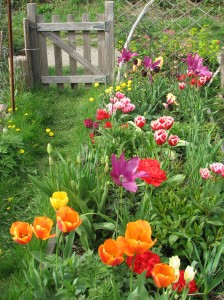Spring Garden Hints
1. Bait garden for slugs – Use Safers Slug bait as it’s an organic one.
2. Work on garden clean-up, weeding and preparing garden beds. Add a handful of lime several weeks before planting. To improve your soil, use mushroom manure or compost.
3. Plant cool season veggies such as lettuce, spinach, kale & cabbage. Plants seeds of peas & sweet peas at this time as well.
4. Start tomato seeds indoors if desired.
April 2015
1. Continue to plant cool season veggies and flowers
2. Transplant raspberries & strawberries if necessary.
3. Plant early potatoes (Yukon Gold & Pontiac)
4. Fertilize perennials with all-purpose fertilizer such as fish fertilizer or organic fertilizer you can make yourself. See below
2 parts bonemeal, 1 part kelp meal, 1 part blood meal.
Apply the fertilizer during growing season.

